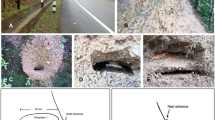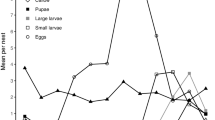Summary
A large population of Halictus ligatus was studied in the subtropical climate of Knights Key, Monroe County, Florida. The dissection of 858 female bees caught on flowers and 420 bees from completely excavated nests gives the following picture of phenology, colony development and social organisation. In the Florida keys, H. ligatus is continuously brooded and multivoltine. However, towards the coldest time of year young gynes may rest in their natal nests rather than found a new colony. This may result in a partial synchronisation of nest initiation when warm weather returns after a particularly cold spell. Most nests are started by a single foundress that usually survives until near the end of the production of reproductives. The first brood is very variable in size and males average 11% of the bees produced at this stage. This figure increases to 56% when the first brood workers begin provisioning. Queens are produced some time after the rise in male production and colony longevity is extended by the presence of some worker brood during this phase. Queens average 16% larger than their workers but appear to exert little inhibition of worker reproductivity: 57% of worker bees mate and 68% show ovarian development. This population is unique amongst social halictines in being continuously brooded, multivoltine and in having such weak physiological caste differentiation. It seems to represent an intermediate stage between the primitively eusocial colonies of H. ligatus found in temperate regions and the communal-like ones of the tropics.
Similar content being viewed by others
References
Batra SWT (1964) Behavior of the social bee, Lasioglossum zephyrum within the nest. Insectes Soc 11:159–186
Brooks RW, Roubik DW (1983) A halictine bee with distinct castes, Halictus hesperus (Hymenoptera: Halictidae) and its bionomics in central Panama. Sociobiology 7:263–282
Chandler L (1955) The ecological life history of Halictus (H.) ligatus Say with notes on related species. Ph D Thesis Purdue University
Eickwort GC (1985) The nesting biology of the sweat bee Halictus farinosus in California, with notes on H. ligatus (Hymenoptera, Halictidae). Pan-Pac Entomol 61:122–137
Eickwort GC, Eickwort KR (1971) Aspects of the biology of Costa Rican halictine bees, II, Dialictus umbripennis and adaptations of its caste structure to different climates. J Kans Entomol Soc 44:343–373
Eickwort GC, Eickwort KR (1972) Aspects of the biology of Costa Rican halictine bees, IV, Augochlora (Oxystoglosella). J Kans Entomol Soc 45:18–45
Jeanne RL (1982) Predation, defense and colony size and cycle in social wasps. In: Breed MD, Michener CD, Evans HE (eds) Biology of social insects. Westview Press, Boulder, pp 280–284
Kirkton RM (1968) Biosystematic analysis of variation of Halictus (Halictus) ligatus Say. Ph D Thesis, Purdue University
Knerer G (1965) Factors regulating social behaviour in sweat bees (Hymnenoptera, Halictidae). Ph D Thesis, University of Toronto
Knerer G (1980) Biologie und Sozialverhalten von Bienenarten der Gattung Halictus Latreille (Hymenoptera, Halictidae). Zool Jahrb Syst 107:511–536
Knerer G, Plateaux-Quénu C (1966) Sur le polymorphisme des femelles chez quelques Halictinae. C Rend Acad Sci 263:1759–1761
Litte M (1977) Aspects of the social biology of the bee Halictus ligatus in New York State (Hymenoptera, Halictidae). Insectes Soc 24:9–36
Michener CD, Bennett FD (1977) Geographical variation in nesting biology and social organisation of Halictus ligatus. Univ Kans Sci Bull 51:233–260
Packer L (1986) Two social Halictine bees from southern Mexico with a note on two bee hunting Philanthines (Hymenoptera, Halictidae and Sphecidae) Pan-Pac Entomol (in press)
Packer L, Knerer G (1985) Social evolution and its correlates in bees of the subgenus Evylaeus (Hymenoptera; Halictidae). Behav Ecol Sociobiol 17:143–149
Raw A (1975) Studies on tropical and temperate bees. Ph D Thesis. University of the West Indies, Kingston, Jamaica
Sakagami SF, Wain FL (1966) Halictus latisignatus Cameron, a polymorphic Indian halictine bee with caste differentiation. J Bombay Nat Hist Soc 63:57–73
Sokal RR, Rohlf FJ (1981) Biometry 2nd edn Freeman, New York
Wille A, Orozco E (1970) The life cycle of the social bee Lasioglossum (Dialictus) umbripenne (Hymenoptera, Halictidae). Rev Biol Trop 17:199–245
Author information
Authors and Affiliations
Rights and permissions
About this article
Cite this article
Packer, L., Knerer, G. The biology of a subtropical population of Halictus ligatus Say (Hymenoptera: Halictidae). Behav Ecol Sociobiol 18, 363–375 (1986). https://doi.org/10.1007/BF00299667
Received:
Accepted:
Published:
Issue Date:
DOI: https://doi.org/10.1007/BF00299667




